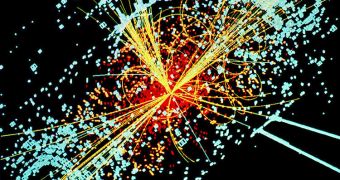The Higgs boson hasn't been proven conclusively yet, scientists have discovered a particle that behaves like predicted and looks, from what we've seen so far, like the particle they were expecting to find, i.e. the Higgs boson, but there may still be surprises left.
The Higgs boson is the last particle predicted by the Standard Model yet to be discovered. It's also the particle that gives everything else mass, so its existence is crucial to our current understanding of the universe.
But the Higgs boson, as predicted, is very unstable and current technology can't detect it outright. But, we can detect the particles it decays into and the standard model provides several ways, or channels, for the Higgs boson to decay.
This is what the Large Hadron Collider was designed to find and that's what it's been doing for the past few years. Particles are smashed together at great speeds, some of the collisions result in the creation of a few Higgs bosons.
The bosons then decay, generating several other particles at certain energy levels. The energy levels depend on the mass of the Higgs boson.
After billions of collisions, last summer, physicists amassed enough data to be sure that there is a particle with an energy of roughly 125 GeV and that the particle decays as expected of the Higgs boson.
What's more, two separate instruments at the LHC found almost the same thing and the chance of the data being a statistical fluke is so small, it's practically impossible.
At this point, most people would be satisfied and call it a day. But it's not that simple. First, there are some discrepancies, CMS, one of the experiments at the LHC looking for the Higgs boson found a particle at 125.8 GeV; Atlas, the other experiment, found it at 125.2 GeV.
The error rates on the measurements allow for the actual figure to be either of those proposed, somewhere in between or even slightly outside the range.
What's more, even if this is the Higgs boson as predicted, it may not be the only one. Supersymmetry, which is still purely on in the theoretical realm, predicts five different boson Higgs at different energy levels.
Once the LHC starts running again, it's currently undergoing maintenance and an upgrade, in 2015, scientists will be able to create collisions twice as powerful which will possibly generate particles heavier than what we've been able to create so far, including further Higgs bosons or, better yet, completely new and unpredicted particles.
Incidentally, if the particle discovered at the LHC is the Higgs boson and it weighs as much as the current measurements indicate, the universe is doomed.

 14 DAY TRIAL //
14 DAY TRIAL //